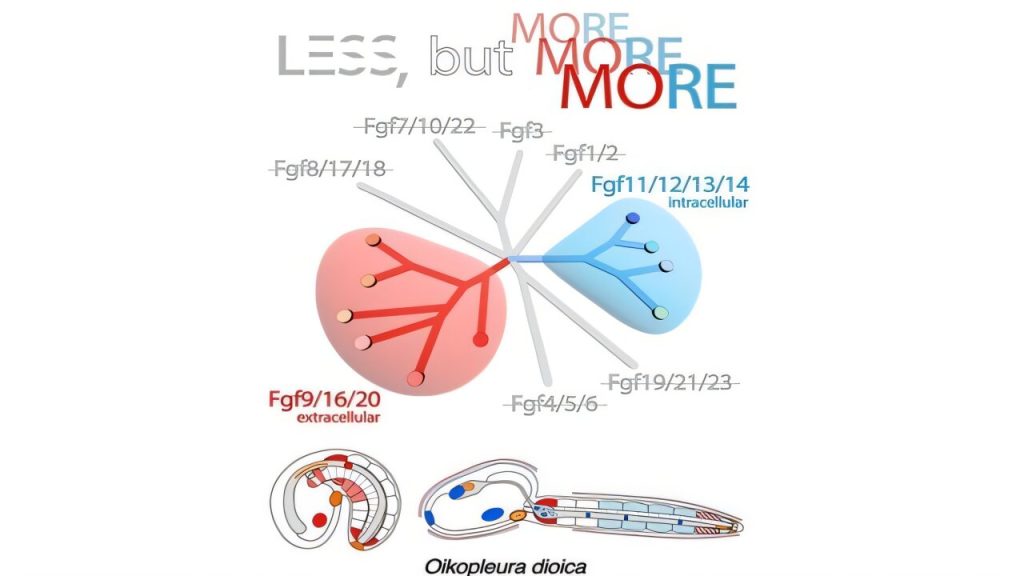Gene Loss Drives Evolution: Scientists Unveil “Less, but More” Model
In a groundbreaking discovery that challenges long-held beliefs about gene evolution, scientists have unveiled a new perspective on how species adapt and change over time. The study reveals that sometimes, less really is more when it comes to genetic makeup and evolutionary progress.
Researchers have found that the loss of certain genes, specifically Fibroblast Growth Factor (FGF) genes, in a group of marine animals called appendicularians has led to significant adaptations in tunicates, a broader group that includes appendicularians. This finding turns the traditional view of evolution on its head, suggesting that losing genetic material can sometimes be a driving force for major evolutionary innovations.
The “Less, but More” Model of Evolution
For decades, scientists have generally assumed that evolution progresses through increasing complexity. However, this new study introduces what researchers are calling the “less, but more” evolutionary model. This concept explains how the loss of genes can actually lead to substantial morphological changes and evolutionary advancements.
Lead researchers explain, “We’ve always thought that adding genes was the primary way organisms became more complex. But our research shows that sometimes, losing genes can open up new evolutionary pathways and lead to significant adaptations.”

Uncovering Cryptic Speciation
One of the most intriguing aspects of this research is its implications for understanding cryptic speciation. Cryptic speciation occurs when organisms that appear identical are actually distinct species. The study suggests that gene loss might play a crucial role in this process, allowing species to diverge in ways that aren’t immediately apparent to the naked eye.
“By losing certain genes, organisms can actually adapt to new environments or develop new traits without drastically changing their outward appearance,” notes a geneticist. “This could explain why we sometimes find species that look identical but are genetically distinct.”
Focus on Appendicularians and Tunicates
The research team focused their study on appendicularians, a group of free-swimming tunicates. Tunicates are marine invertebrates that include sea squirts and salps. By examining the genetic makeup of these creatures, the scientists were able to trace the loss of FGF genes and its impact on tunicate evolution.
Researchers note, “Appendicularians have undergone some remarkable adaptations. By losing these FGF genes, they’ve developed unique features that set them apart from other tunicates. It’s a perfect example of how gene loss can drive evolutionary innovation.”
Implications for Evolutionary Biology
This new perspective on evolution has far-reaching implications for the field of evolutionary biology. It suggests that scientists need to consider both gene gain and gene loss when studying how species evolve over time.
“We need to rethink our approach to studying evolution,” notes a geneticist. “This research shows that we can’t just focus on what genes are added to a genome. We also need to consider what genes are lost and how that loss might drive adaptation and speciation.”
Future Research Directions
The findings of this study open up new avenues for research in evolutionary biology. Scientists are now eager to explore whether similar patterns of gene loss-driven evolution can be found in other groups of organisms.
Researchers are already planning follow-up studies. “We want to see if this ‘less, but more’ model applies more broadly across the tree of life,” they say. “It’s possible that gene loss has been a major driver of evolution in many different species, including humans.”
As researchers continue to unravel the complex mechanisms of evolution, this study serves as a reminder that nature often finds surprising ways to innovate. The loss of genes, once thought to be purely detrimental, may in fact be a powerful tool in the evolutionary toolkit, driving species to adapt, change, and thrive in new ways.
This paradigm-shifting research not only challenges our understanding of evolution but also opens up exciting new possibilities for future studies. As we continue to explore the intricate world of genetics and evolution, we may find that when it comes to adaptation and survival, sometimes less really is more.

